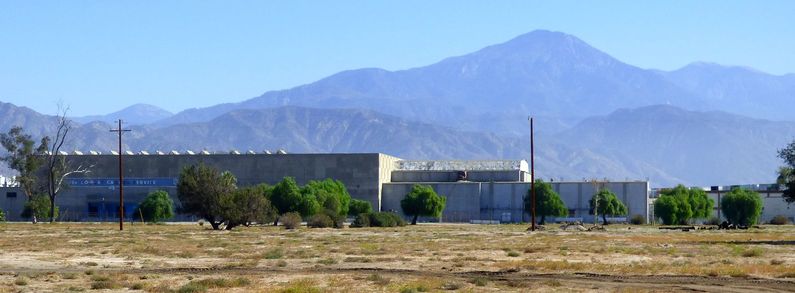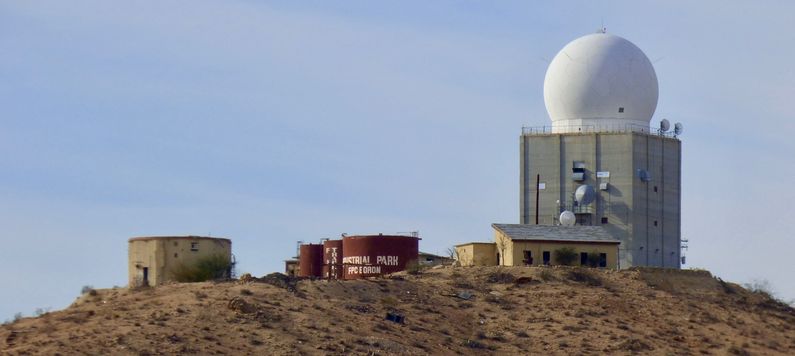Boron Air Force Station
|
Boron Air Force Station (1952-1975) - A Cold War Air Force Radar Station first established as Atolia Air Force Station in 1952 near Boron, San Bernardino County, California. Later named Boron Air Force Station on 1 Dec 1953 after the location. Initially assigned a Permanent ID of P-59 and later a Sage ID of Z-59. Abandoned by the Air Force and transferred to the FAA in 1975.
HistoryEstablished in 1951 and became operational in February 1952 manned by the 750th AC&W Squadron. The station initially had both a Ground-Control Intercept (GCI) and early warning mission. The early warning mission involved tracking and identifying all aircraft entering their airspace while the GCI mission involved guiding Air Force interceptors to any identified enemy aircraft. Controllers at the station vectored fighter aircraft at the correct course and speed to intercept enemy aircraft using voice commands via ground-to-air radio. Initial equipment included two FPS-10 search/height-finder radars. These radars were upgraded to an FPS-20 search radar and an FPS-6 height-finder radar with a second FPS-6A height-finder added in 1959, all in preparation for the transition to the SAGE System. Also added in the pre-SAGE System upgrades was the installation of the GPA-37 analog intercept control computer system. The GPA-37 was a large analog electro-mechanical computer system that allowed the control of aircraft intercepts by either voice command or by a time-division data link. The GPA-37 system remained at Boron AFS between 1958-1961. SAGE System TransitionThe transition of the manual GCI system to the automated SAGE system began with the installation of the FST-2 coordinate data transmitter and search radar upgrades. The FST-2 equipment digitized the radar returns and transmitted the digital returns to the SAGE direction center. Under the SAGE System, interceptor aircraft were directed to their targets by the direction center computers and controllers, greatly reducing the need for local controllers and equipment at every radar station. The FST-2 was a very large digital system using vacuum tube technology. Over 6900 vacuum tubes were used in each FST-2 requiring 21 air-conditioned cabinets, 40 tons of air conditioning, 43.5 kva of prime power, and usually a large new addition to the operations building. The FST-2B modification added two more cabinets but with newer solid-state (transistor) technology to process coded responses from aircraft transponders. SAGE System Operation
The site began operation as a SAGE site in 1961 initially feeding the Norton SAGE Direction Center DC-17 and the site also transitioned to a joint-use ADC/FAA site. After the transition, the search radar set was upgraded to an FPS-35 frequency diversity radar. The FPS-35 was a massive seventy-ton radar set that required an eighty-five-foot concrete tower to hold the massive thirty-five-foot wide antenna. The FPS-35 installation alone cost 13.5 million dollars. By 1963 the two FPS-6 height-finder radars had been replaced by an FPS-26A and an FPS-90 height-finders. The Norton SAGE Direction Center DC-17 closed on 25 Jun 1966 and control over Boron AFS shifted to Luke SAGE Direction Center DC-21 where remained until the site closed in 1975. With the transfer of the site to the FAA in 1975, the site continued to supply data to the Luke SAGE Direction Center DC-21 until it closed in 1983. The site was data-tied to successor control system and continues to provide data. Gap FillersBoron AFS was responsible for the maintenance of two remote unattended gap-filler radar sites. The unattended gap filler sites were placed in locations where the main search radar lacked coverage. These sites were equipped with short range FPS-14 or FPS-18 search radars and FST-1 Coordinate Data transmitters that sent digitized radar target data to a SAGE direction center and to the main radar site. Both the radar set and the FST-1 were dual channel to increase site up time. Maintenance teams were dispatched for regularly scheduled maintenance or when fault indicators on the FSW-1 remote monitoring equipment suggested the site had problems. The FSW-1 also allowed remote operation of specific functions such as channel changes for the radar and for the FST-1, it also allowed remote operation of the diesel generators at the gap filler site. The Boron AFS gap-filler radars were located at Shafter and Joshua Tree, California. A third gap-filler was planned but not built.
BUIC SystemBoron AFS became a manual BUIC I NORAD Control Center (NCC) site in 1962 but was not selected as a BUIC II or BUIC III site. With the implementation of the automated BUIC II and BUIC III systems at other locations, Boron AFS returned to a surveillance role. ClosureBoron AFS and the 750th were deactivated on 30 Jun 1975. The site was transferred to the FAA on 30 Jun 1975. Now listed as Boron FAA Radar Site QSR, reportedly operating the CARSR minimally attended radar since 2012. Boron FAA Radar SiteThis site became an FAA radar site in 1975, furnishing radar track data to the FAA ARTCCs and to USAF Direction Centers. The initial FAA FPS-67B search radar remained in operation until it was modified to become a CARSR radar with a 1561 Antenna. A FYQ-47 Common Digitizer was probably placed in service by February 1973 when the USAF/FAA FST-2 to FYQ-47 replacement program was completed. By 1990 the site was equipped with an FPS-67B search radar and a CD-2A Common Digitizer. The Boron CD-2A was scheduled to receive an upgrade kit to implement three level weather data processing in June 1992. CARSR RadarThe nationwide replacement program converting FAA legacy radar systems to the CARSR radar configuration was completed by 17 Aug 2015 and Boron FAA Radar Site was a part of that program. Legacy FAA radars underwent a Service Life Extension Program (SLEP) that replaced key components in the vintage ARSR-1, ARSR-2, FPS-20, FPS-66 and FPS-67 radars. The CARSR program replaced legacy klystron radar transmitters with a solid-state transmitter as well as renovating the radar receiver and signal processor. The CARSR modification also included common digitizer functionality making a separate common digitizer unnecessary. The Boron FAA Radar Site is now operating with the CARSR radar. The secondary radar at this site is an ATCBI-6 Beacon set. The radar site data is now available to the USAF/NORAD Battle Control System-Fixed (BCS-F) operations centers (EADS & WADS) as well as the FAA Los Angeles ARTCC (ZLA) and adjacent ARTCCs. Other federal agencies have access to the data under the Homeland Security umbrella. Physical PlantThe physical plant of the site was divided into the main site, a cantonment area, a housing area and a radio site. The main site housed the operations buildings, the radar towers, and the backup generators. The cantonment area housed the enlisted barracks, the bachelor officer's quarters, the orderly room, the dining hall, the motor pool and other support buildings. Apart from the main site was a small 27 unit housing area for married personnel. A separate Ground to Air Transmitter/Receiver (GATR) radio site housed the radio equipment for directing aircraft intercepts.
Current StatusThe main site is now the FAA Radar Site QSR and was data tied to the JSS and successor networks. The cantonment area was a federal prison until it was closed in 1999.
See Also:
Sources:
Visited: 6 Dec 2016
| ||||||||||||||||||||||||||||||||||||||||||||||||||||||||||||
